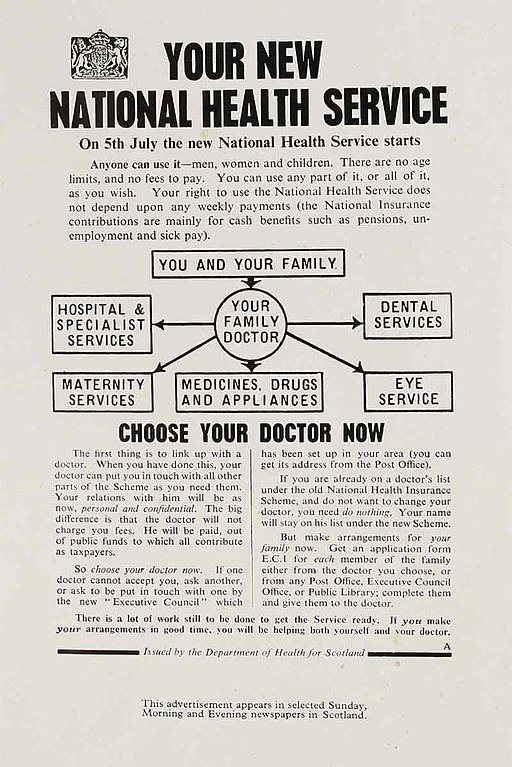
NHS 70
On 5th July, the National Health Service (NHS) celebrated its 70th birthday. It was on that day in 1948 that Aneurin Bevan, the Health Secretary in Clement Attlee’s government, launched a scheme which opened health care to everyone, rich or poor, at Park Hospital in Davyhulme, Manchester (now called Trafford General Hospital).
From the summer of 1948, for the first time all the medical advisors and providers across the country, including the, hospitals, doctors, nurses, dentists, pharmacists, chiropodists and opticians, came together under a single umbrella organisation to provide services that were free of charge. Run by regional health boards which the government created to cover the entire country, 2,751of Britain’s 3000 hospitals were removed from local authority and charity control and nationalised. Within a day of the NHS opening, thanks to a massive administration programme, 94% of the British public were already enrolled in the system.
An article in The Guardian newspaper (from January 2018) records that on 5th July 1948, Bevan met the new health services very first patient; 13-year-old Sylvia Diggory. She was suffering from acute nephritis, a life-threatening liver condition. Looking back on her experience, Sylvia said: “Mr Bevan asked me if I understood the significance of the occasion and told me that it was a milestone in history – the most civilised step any country had ever taken.”
Although the idea of the NHS was free healthcare for all, it was only four years later that funds were required to aid its development, and in 1952 prescription charges were introduced for people needing drugs after a visit to the doctor or hospital. These early fees were rather lower than the £7.10 English patients currently pay for a standard prescription (fees have been abolished in Wales and are being phased out in Scotland).
The unification of health resources has led to some major breakthroughs over the last seven decades; the first mass vaccination programme in 1958 that targeted and vastly reduced polio and diphtheria, the first heart transplant in 1968, the first test tube baby in 1978, mass screening for the prevention of breast cancer in 1988.
It was in 1962 that the Health Minister, Enoch Powell, set out ‘The Hospital Plan’, a 10-year vision for hospital building. This plan was driven by the desire to provide a separate district hospital for every 125,000 people, so that each community had somewhere geographically close to go to in a medical emergency.
There is no doubt that the current NHS has problems. Funding is suffering an all time dip and staff morale is often cited as being at a critical low, yet it cannot be denied that the UK is lucky to have a service which allows everyone to walk through its doors and receive emergency medical help whenever it’s needed, usually with no fee attached. A spokesperson for NHS England said, “We are all proud of our NHS. It has delivered huge medical advances and improvements to public health, meaning we can all expect to live longer lives… The NHS continues to drive innovations in patient care, including mechanical thrombectomy to improve stroke survival, bionic eyes to restore sight, and surgical breakthroughs such as hand transplants. Looking to the future, the NHS is becoming more integrated and investing in new medicines, genetic research and digital technologies like apps and artificial intelligence, which will ensure we continue to live longer and healthier lives.”
